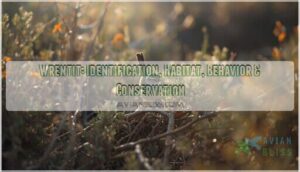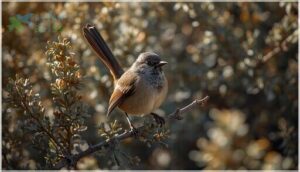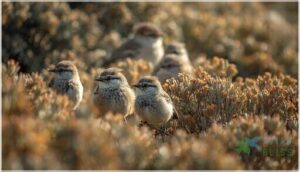This site is supported by our readers. We may earn a commission, at no cost to you, if you purchase through links.

If you’ve heard their distinctive bouncing-ball song echoing through California’s coastal scrub, you’ve encountered one of North America’s most faithful homebodies. The wrentit’s extreme site loyalty and monogamous devotion make it unlike any other bird on the continent. Understanding how to identify these secretive residents and where they live reveals a bird that has mastered survival in one of the West Coast’s most overlooked ecosystems.
Table Of Contents
Key Takeaways
- Wrentits spend their whole lives in dense West Coast shrubland, rarely moving more than a few hundred meters from where they hatch.
- These birds pair for life, share all parenting duties, and defend small territories together year-round.
- Their population is shrinking due to habitat loss and fragmentation, with interior groups at higher risk.
- Wrentits blend in with their brown plumage and long tails, but pale eyes and a bouncy, trill-like song help you spot them.
Wrentit Identification and Physical Features
If you spot a small, long-tailed bird skulking through dense coastal brush, you might be looking at a wrentit.
These secretive songbirds have several distinctive features that set them apart from other species. Let’s break down the key physical traits that will help you identify them in the field.
Size and Body Shape
You’ll spot a wrentit by its distinctive physical characteristics right away. Adult length measures 14 to 17 centimeters, with body mass ranging from 13 to 16 grams. The bird’s morphology includes notable shape features:
- Plump, rounded body with a large head
- Long, upward-cocked tail enhancing its silhouette
- Short, rounded wingspan of 17.5 to 18 centimeters
Growth rate from nestling to adult takes just 12 to 15 days. They thrive in the California coast chaparral.
Color Patterns and Distinctive Markings
When you look at a wrentit, you’ll notice its plain gray-brown to reddish-brown plumage variation with no bold spots or wingbars. The bird’s camouflage effectiveness comes from subtle, blurry streaking patterns across the breast and belly. This feather structure creates a soft, fluffy appearance.
Five subspecies show color gradients from dark brown in coastal Oregon to pale brown in southern California, making wrentit bird identification challenging in the field. They’re known to form lifelong pair bonds shortly after hatching.
Eye and Bill Characteristics
Beyond the muted feathering, you’ll find two standout features for wrentit bird identification: the pale cream or whitish iris and the short, slightly curved bill. The iris coloration stays consistent across all geographic ranges, while the bill measures just 12–14 mm—perfectly adapted for gleaning insects and crushing berries.
- Iris Coloration: Adult birds show a striking pale eye that contrasts sharply with darker facial feathers, making it a reliable field mark.
- Bill Morphology: The stout, horn-colored bill processes prey from tiny ants to 10 mm caterpillars with ease.
- Aging Changes: Juveniles start with brownish-gray irises that lighten to whitish by their first breeding season.
Comparison With Similar Species
With those field marks in mind, you’ll want to know what sets this bird apart from lookalikes. Bushtit differences include size—they’re noticeably smaller at 11 cm versus the wrentit’s 14–15 cm. Bewick’s Wren shows a bold white eyebrow and longer bill, while Marsh Wren sports striped plumage and favors wetlands over chaparral. Range overlap with these species is limited, but understanding genetic relations helps: wrentits belong to the Asian parrotbill family, not true wrens. These ID tips guide accurate songbird identification when field marks blur.
| Species | Key Field Marks | Habitat Preference |
|---|---|---|
| Wrentit | Pale iris, short curved bill, subtle streaking | Dense chaparral, coastal scrub |
| Bushtit | Tiny size (11 cm), darker iris in males | Open woodlands, travels in flocks |
| Bewick’s Wren | White eyebrow, long slender bill, white-tipped tail | Brushy areas, wider distribution eastward |
Wrentit Habitat and Geographic Range
You’ll find wrentits in a surprisingly narrow strip along the West Coast. Their range runs from Oregon down through California into northern Baja California, but they rarely wander far from their preferred coastal scrub and chaparral.
Let’s look at where these birds live and what keeps them bound to such a specific area.
Preferred Vegetation and Ecosystems
You’ll find wrentits thriving where dense shrubs dominate—chaparral stands with over 70% cover often support more than 10 breeding pairs per hectare. Their preferred ecosystems share a common thread: thick, low vegetation that offers both shelter and food.
- Mature chaparral with poison oak and evergreen foliage
- Coastal sage scrub featuring California sage and coyotebush
- Riparian woodlands with willow, blackberry, and coffeeberry thickets
Coastal and Interior Distribution
Along the West Coast, wrentits form two distinct groups shaped by habitat segregation and dispersal barriers. Coastal populations thrive in continuous chaparral from Oregon to Baja California, while interior birds occupy fragmented thickets along foothill streams. This geographic variation drives genetic divergence and creates striking differences in population density—with conservation implications becoming clearer as urbanization increases isolation.
| Region | Population Density | Habitat Type |
|---|---|---|
| Coastal Belt | 40% higher than interior | Coastal scrub, dense chaparral |
| Interior Zones | Lower, declining trends | Riparian thickets, oak understory |
| Urban Edges | Fragmented, isolated | Habitat islands, reduced connectivity |
Elevational Range
From sea level to 2,300 meters, wrentits occupy a relatively narrow elevational band tied directly to chaparral and coastal scrub availability. Higher population density occurs in foothill zones where habitat variation fosters dense shrub cover.
Nesting habits shift with elevation—nests sit higher in shrubs at mountain sites.
Climate impact threatens this range as warming pushes suitable habitat upward, complicating conservation status across their geographic distribution.
Habitat Fragmentation and Range Limits
Urban sprawl carves chaparral into isolated islands, trapping wrentit populations in genetic isolation. Highway 23 in Southern California forms a major dispersal barrier, creating distinct genetic clusters.
Adults rarely move beyond 400 meters from natal sites, and patches under 40 acres can’t sustain stable populations.
This habitat fragmentation blocks range expansion and erodes genetic diversity, especially threatening interior populations where declines reach 0.5% annually—elevating local extinction risk across their geographic range.
Wrentit Behavior and Social Structure
Wrentits stand out among songbirds for their remarkably tight social bonds and year-round territorial behavior. These birds rarely fly more than a few yards at a time and spend most of their lives hidden within dense shrubs.
Let’s look at the key behaviors that define how wrentits live and interact with their surroundings.
Foraging and Feeding Habits
You’ll find Wrentits gleaning insects from dense shrubs over 85% of the time. Their diet shifts with the seasons—spring and summer bring caterpillars and beetles, while autumn and winter mean more berries and poison oak seeds.
They rarely venture to open ground, spending upwards of 75% of daylight hours foraging within their defended territories. Territory defense keeps food sources secure year-round.
Monogamous Pair Bonds
Wrentits form monogamous pair bonds that last a lifetime, with bond formation happening as early as 30 to 40 days after fledging. Mate fidelity exceeds 85%, and divorce rates stay below 1%.
Both partners share parental roles equally—nest building, incubation, and feeding young.
Territory stability reinforces their bonds, with over 90% of pairs remaining on the same territory throughout their lifespan durability of five-plus years.
Over 90% of wrentit pairs stay on the same territory for life, reinforcing bonds that can last five years or more
Territoriality and Song Behavior
Their strong bonds extend into how pairs defend their turf. You’ll notice wrentits maintain territories year-round, ranging from 0.5 to 3 acres. Both partners actively participate in territory defense through distinctive song duets. Males produce 3 to 5 “pit” notes followed by a trill, while the female song features fewer notes without the trill. Their vocal range peaks at sunrise, with frequencies between 2–4 kHz carrying through dense brush.
Key territorial behaviors include:
- Cooperative singing between mates functions as both territory defense and mate-guarding
- Singing frequency remains consistent throughout seasons, not just during breeding
- Less than 1% of breeding adults switch territories between seasons
- Males show stronger aggression toward male intruders, females toward female intruders
Tail Movement and Flight Patterns
After a burst of song, you might spot the wrentit’s tail posture—cocked sharply upward, almost like a flag.
This bird’s flight distance rarely exceeds twenty meters, with short rounded wings built for weaving through dense brush. Aerial maneuvers rely on rhythmic tail pumping, setting wrentit bird characteristics apart from sparrows and thrashers in similar habitats.
Wrentit Diet and Reproductive Habits
Wrentits eat a mix of insects and berries that changes with the seasons.
Their breeding habits show careful attention to nest building and long-term care of their young. You’ll see how their diet fuels their reproductive cycle and what makes their parenting approach stand out.
Insect and Berry Consumption
You’ll find wrentits rely heavily on insect consumption for most of their diet. Beetles, caterpillars, ants, larvae, and spiders make up 60–70% of their food intake by mass. These insectivores glean prey from shrub surfaces, hopping branch to branch.
Berry consumption becomes important during fall and winter, with poison oak seeds, elderberry, and coffeeberry providing critical nutrition when insects grow scarce.
Seasonal Diet Shifts
During spring and summer, insect consumption makes up 70% of the wrentit diet, with berry dependence dropping to just 30%. Winter foraging shifts dramatically—berry consumption jumps beyond 60% as insects become scarce.
This dietary flexibility lets adults thrive year-round, though the juvenile diet remains insect-heavy until fledging. Poison oak berries often dominate coastal wrentit feeding behavior from December through February.
Nesting and Egg Incubation
During breeding season, both parents spend 6–14 days weaving bark fiber and spiderwebs into a 3.5-inch nest, usually 1–4 feet high in dense shrubs like coyotebrush or manzanita. Nest site selection prioritizes concealment within native vegetation.
Clutch size ranges from 3–4 greenish-blue eggs. Incubation roles are shared equally for 14–16 days, with parents alternating shifts.
Nesting success averages 76% despite predation pressures affecting breeding outcomes.
Fledgling Care and Development
Nestlings fledge at 15–16 days, but parental care continues well beyond this initial flight. Both adults provide food for fledglings for an average of 32.5 days, with some individuals receiving care for up to 41 days before becoming independent.
Key fledgling development milestones include:
- Survival rates average 31% annually, with predation as the primary mortality factor
- Growth timing shows rapid feather development by Day 7, enabling self-feeding practice within weeks
- Feeding behavior shifts from complete dependency to progressive foraging alongside parents
- Dispersal patterns begin 30–41 days post-fledging, with most juveniles moving 33–700 meters from natal territories
This extended period of parental care is valuable for avian demography studies, allowing researchers to track family flocks during post-breeding periods.
Wrentit Conservation and Subspecies
Wrentit populations face real challenges across their limited West Coast range. Understanding these threats and the subspecies variations helps you see the full conservation picture.
Here’s what you need to know about population trends, habitat threats, subspecies differences, and current protection efforts.
Population Trends and Threats
You’ll notice that wrentit populations have dropped 34% since 1966. Habitat fragmentation and urban development are the main culprits, cutting off genetic isolation between groups.
Climate projections warn of more wildfires ahead, threatening their brushy homes. Demography studies show interior populations declining faster than coastal ones.
These avian conservation challenges demand immediate attention to protect remaining wrentit habitat.
Habitat Loss and Conservation Status
You’ll find the wrentit listed as Least Concern by IUCN, yet it sits on the Yellow Watch List due to its restricted habitat range along California’s coast. With 2.2 million individuals globally and a Continental Concern Score of 14 out of 20, conservation efforts now target habitat fragmentation and urban development.
Preserving genetic diversity through habitat restoration remains essential for avian conservation success.
Recognized Wrentit Subspecies
You’ll encounter five recognized wrentit subspecies, each displaying distinct plumage variation tied to their geographic clades. From the darkest C. f. phaea in coastal Oregon to the palest C. f. henshawi stretching into Baja California, these subspecies ranges reflect genetic divergence shaped by California’s mountains and rivers.
Mitochondrial DNA studies confirm this wrentit classification, with subspecies variation supporting their current taxonomic status across regional differences.
Ongoing Conservation Efforts
You’ll see wrentit bird conservation depends on coordinated avian conservation efforts across multiple fronts. Habitat restoration projects like Hahamongna Watershed Park’s 1.7-million-cubic-yard sediment removal have established native vegetation critical for population monitoring. Conservation strategies now integrate:
- Community science initiatives training residents in avian monitoring
- Policy actions targeting 50% population increases
- Adaptive management using annual banding data
- Public engagement through education programs reaching 140+ participants yearly
Frequently Asked Questions (FAQs)
What is a wrentit?
You might mistake it for an unspectacular brown bird, yet the Wrentit stands alone—North America’s only babbler.
This small songbird measures six inches long, weighing just half an ounce, with distinctive pale eyes.
Where do wrentit live?
You’ll find wrentits along the West Coast from Oregon through California to northern Baja California.
They inhabit coastal scrub and chaparral, thriving in dense shrublands from sea level up to 2,300 meters elevation.
What does a wrentit sound like?
You’ll recognize the wrentit’s song as a distinctive bouncing-ball sound. Males produce accelerating trills lasting about four seconds.
Their calls include flat chirps for contact and loud, scolding rattles as alarm signals.
What genus is a wrentit?
You’ll find the wrentit in the genus Chamaea, where it stands alone as the only species.
This unique taxonomic position highlights its distinctive evolutionary relationships and classification history within bird taxonomy.
What does a Wrentit look like?
You’ll spot a plump brownish-gray songbird with a long, upright tail and short wings.
Wrentit plumage variations show subtle streaking below, pale eyes, and a stubby bill—juveniles display similar coloration before molting.
What is the Wrentit habitat?
You’ll find this bird where dense shrub density meets coastal scrub and chaparral—a living symbol of ecosystem interdependence.
Its wrentit habitat and range spans West Coast thickets, where climate impacts and limiting factors shape survival through habitat restoration needs.
What family is the Wrentit in?
The Wrentit bird species belongs to the Paradoxornithidae family, not Chamaeidae. Molecular phylogeny revealed Asian affinities and babbler relationships, leading to its reclassification.
This shift reflects its unique evolutionary lineage and taxonomic history among babblers.
What bird makes a rolling R sound?
If you hear a bird making a rolling R sound, chances are you’ve come across a Wrentit.
This bird’s bouncing-ball song stands out—its accelerating, high notes create a rolling rhythm that’s key for identification and territory.
What is the range of the Wrentit?
Along the West Coast, coastal scrub forms the heart of this bird species’ range. Habitat boundaries hug dense vegetation, stretching from southern Washington through California to Baja California. Elevational limits reach 2,300 meters, creating pockets of population isolation.
Do Wrentits migrate seasonally or remain local?
Like a stone anchored in a stream, this sedentary bird stays put all year. Its migration patterns are almost nonexistent.
Habitat fidelity keeps pairs in the same territory, with only short juvenile dispersal—ensuring a narrow bird species range.
Conclusion
Like a hidden thread woven into the chaparral, the wrentit binds together the story of California’s coastal wild lands. You might miss its quiet life if you rush by, yet those who pause find the marks of resilience and devotion with every flash of its tail or call in the brush.
Learning about these elusive birds gives you a glimpse into the steady heartbeat of an overlooked world, enduring just out of sight but never out of place.
- https://app.mybirdbuddy.com/birds/wrentit/4ec4928e-9b92-4c12-bb65-3af69f22b145
- https://kevinburnslab.com/wp-content/uploads/2016/05/burnsbarhoum2006.pdf
- https://academic.oup.com/jhered/advance-article/doi/10.1093/jhered/esaf063/8248397
- https://www.laspilitas.com/California_birds/Babblers/Wrentits_in_your_garden.htm
- https://digitalcommons.usf.edu/cgi/viewcontent.cgi?article=12349&context=condor











